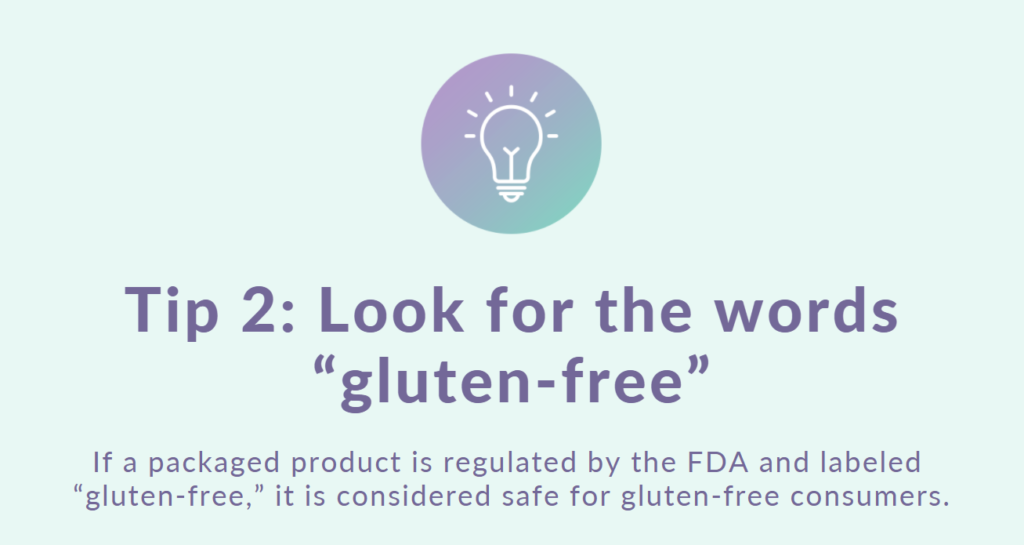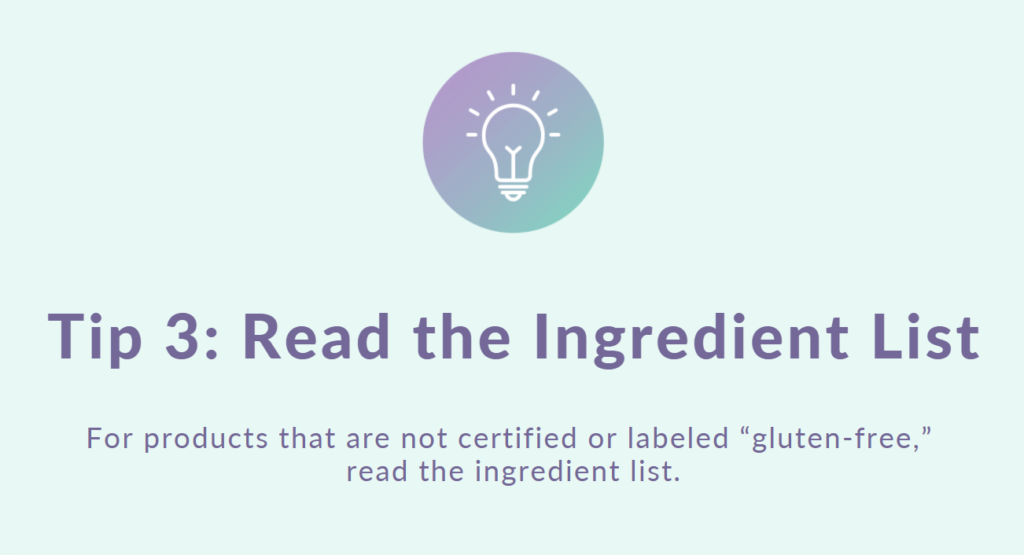3 Tips for Gluten-Free Label Reading
Download the Printable Version of this Educational Bulletin
Updated January 30, 2023
When you’re living gluten-free, making sense of food labels can be a bit of a puzzle you must solve before you can feel confident putting that product in your cart and bringing it home to consume. We put together three tips for reading labels on packaged food products to help you figure out if they’re safe for you, or anyone in your household, avoiding gluten.

Tip 1: Look for Third-Party Certification
A product that carries a third-party certification, such as GIG’s Gluten-Free Certification Organization (GFCO) distinctive mark, is considered safe for gluten-free consumers.
The GFCO mark represents a rigorous certification process that includes:
- Ingredient analysis
- Plant audits
- Frequent testing
- Off-the-shelf product testing
- Verifying there is no more than 10ppm gluten content in tested foods
Note that the U.S. Food and Drug Administration (FDA) sets their gluten-content threshold at less than 20 ppm of gluten, making the GFCO’s standard twice as strict.

Tip 2: Look for the words “gluten-free”
See the words “gluten-free” on a label, but not seeing a gluten-free certification mark? If a packaged product is regulated by the FDA and labeled “gluten-free,” it is considered safe for gluten-free consumers. The FDA regulation says that manufacturers are required to comply with the gluten-free definition detailed in their regulation.
The FDA regulation also applies to using the terms “no gluten,” “free of gluten,” and “without gluten” on product labels. If you see any of those terms, and the manufacturer is following the FDA’s gluten-free regulations, then the food should be gluten-free.
*A product that is labeled gluten-free may include the term “wheat” in the ingredient list (such as “wheat starch”) or in a separate “Contains wheat” statement, but the label must also include the following statement: “The wheat has been processed to allow this food to meet the Food and Drug Administration (FDA) requirements for gluten-free foods.”
If “wheat starch” is an ingredient in a GFCO–certified product, the wheat has been processed to such an extent that the food meets the GFCO standard of 10 ppm or less gluten.

Tip 3: Read the Ingredient List
For products that are not certified or labeled “gluten-free”, the best way to make sure you are eating or serving gluten-free packaged foods is to read the ingredient list.
What do you want to avoid? If any of the following are present on the ingredient list, the product is not gluten-free:
- Wheat (including all types of wheat such as spelt, emmer, farro, and durum)
- Rye
- Barley
- Oats*
- Malt
- Brewer’s yeast
*An important thing to note about oats: Unless the words “gluten-free” or a gluten-free certification mark are on the oats packaging, oats may not be gluten-free. In the U.S., the FDA does not allow descriptions in ingredient lists, so you won’t see “gluten-free oats” as one of the ingredients. Other countries do allow descriptive ingredients so you might see this on products from other countries, such as Canada. See Are Oats and Oat Flour Gluten-Free for more information. The safest oat products are those that have been certified gluten-free. While products labeled gluten-free should comply with the FDA definition of containing no more than 20 ppm of gluten, this is not third-party verified. GFCO’s standard for gluten-free is 10 ppm of gluten or less.
Confused About That “May Contain Wheat” Statement?
Statements such as “may contain wheat” or “processed on equipment that handles wheat” are not relevant to the gluten-free status of a product that is certified or labeled gluten-free. These are voluntary statements that manufacturers may use to be transparent or to alert consumers who have wheat allergies – not gluten sensitivities.
If a product is either labeled or certified gluten-free, these statements are not relevant to the gluten-free status of a product because that product would meet the standard for gluten-free. If the product is not certified or labeled gluten-free, the product may not be safe. If you aren’t sure, contact the manufacturer directly. They should be able to furnish you with the information you need to make safe food choices.
About Wheat Starch
Someone allergic to wheat should avoid wheat starch. For someone avoiding gluten, wheat starch could contain gluten unless it is in a product that is certified or labeled gluten-free. In that case, the gluten in wheat starch has been processed out. As long as the product is certified or labeled gluten-free, it is safe for someone avoiding gluten.

BONUS: Save Some Time Reading Labels
Reading packaged food labels is a critical step for ensuring food safety. You can save some of the time you might spend reading labels by seeking out GFCO-certified products in advance of shopping at stores or online.
Search the GFCO Product Directory to identify the products and brands that have gone through GFCO’s detailed testing, auditing, and review process and are allowed to put the official GFCO certification mark on their packaging.
Look for the new GFCO mark on product labels to rest assured that the food item is safe. You may still see the old GFCO mark as it is being phased out. You can also check if the mark is still valid and up-to-date with a quick search of the GFCO Product Directory.

Figuring out if the food you’re buying off the shelf is gluten-free and safe to eat does not have to be confusing. We are here to help you live safely gluten-free.
Want to Know More?
Trusting packaged food labels can be challenging, particularly when you are new to living gluten-free. Here is some additional information to explain the role of the FDA, the USDA, and the regulations that affect food safety and labeling.
FALCPA: The Act that Protects You
FALCPA (the “Food Allergen Labeling and Consumer Protection Act”) is an Act that passed in 2004. According to the FDA’s website, FALCPA was enacted to “improve food labeling information for the millions of consumers who suffer from food allergies. The Act will be especially helpful to children who must learn to recognize the allergens they must avoid.”
FALCPA applies to FDA-regulated products only.
The FDA’s Role
The FDA regulates the vast majority of packaged foods. The FDA gluten-free labeling regulation is a part of FALCPA.
The USDA’s Role
The USDA also regulates certain foods, in particular: meats, poultry, egg products (but not actual eggs) and mixed products that generally contain more than 3% raw or 2% cooked meat (for example, some soups and frozen entrees). Products regulated by the USDA are not required to comply with FALCPA, but an estimated 80-90% do so voluntarily.
| FDA | USDA | |
| Types of Food Regulated | Most packaged
foods |
Meats
Poultry Egg products (but not eggs) Mixed products (with >3% raw or >2% cooked meats) |
| Part of FALCPA – “Food Allergen Labeling and Consumer Protection Act” | Yes | No, but many food producers follow it anyway |
What Does FALCPA Require?
What does FALCPA require? The FALCPA labeling regulations require that the top nine allergens be clearly identified, including wheat. Derivatives of wheat, such as “modified food starch,” must clearly indicate that “wheat” is the source when this is the case.
The 9 Major Food Allergens (FALCPA)
- Milk
- Eggs
- Fish (e.g., bass, flounder, cod)
- Crustacean shellfish (e.g., crab, lobster, shrimp)
- Tree nuts (e.g., almonds, walnuts, pecans)
- Peanuts
- Wheat
- Soybeans
- Sesame
What’s missing?
Rye and barley are not in the FALCPA top nine allergens, so anything derived from them in an ingredient list, like malt from barley, does not need to include a clarification of the source. If you are gluten-free, you need to not only avoid wheat gluten but also gluten from rye and barley.
More About “Contains” Statements
If you see a “Contains” statement, or other indication that a USDA-regulated product is complying with FALCPA, then simply look for the word “wheat.” If there is any doubt about whether a product is complying with FALCPA labeling, the following ingredients may be derived from wheat.
Avoid these or investigate further:
- starch
- food starch
- modified food starch
- dextrin
Remember: Wheat-free is not the same as gluten-free. A product can be wheat-free but still contain gluten from rye or barley.
Download the Printable Version of this Educational Bulletin
For Further Reading
The full FDA Ruling on Gluten-Free Labeling
Gluten-Free Labeling of Food (FDA)
Small Entity Compliance Guide: Gluten-Free Labeling of Foods
